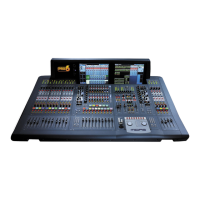119
PRO6 Live Audio System
Owner’s Manual
Chapter 12: Soloing
With solo you can isolate the sound from a single channel, which is helpful in fault
finding and when equalising a signal. Pressing a solo button cuts all signals routed to
the monitor output, except the one local to the solo button (mix minus is bus mode of
the aux outputs, and does not affect the solo buses — if you solo an aux in mix minus
mode, you still only solo that channel). So, you can monitor a signal at a level
proportional to its level in the mix, in the same stereo position in the mix and with the
same reverberation as in the mix.
The PRO6 Control Centre has two independent solo systems, solo A and solo B. Both
have monitor and headphone outputs, and both can be used to PFL or AFL signals from
the same sources throughout the control centre. This flexible solo bus configuration
makes soloing of three-way monitor mixes — in-ears going to solo A and wedge going
to solo B — possible and also greatly enhances the usefulness of the control centre for
dual (two-person) operation (independent soloing).
Note: Solo A and B are not to be confused with area A and B (as in dual operation) and
monitor A and B.
Using solo A/B
With solo A/B on, solo goes to the selected solo bus with the following conditions:
• If the solo button is pressed only for a short time, the soloing to the selected solo
bus remains active when the button is released. If the solo button is held down, the
soloing to the selected solo bus is cancelled when the button is released.
• Pre-fader audio is sent to the selected solo bus if the associated PFL control for that
bus is active. Post-fader audio is sent to the selected solo bus if the associated PFL
control is inactive.
• Unless multiple solo activations to the same solo bus are concurrent, the solo
activation that occurred last — while the respective solo add mode (A or B) is
inactive — cancels all earlier solos to the same bus before it activates.
• Solos can also be operated from a VCA master when the channel to which they
belong is a member of that VCA. This is in addition to the local operation.
• Pressing the solo clear button associated with the solo bus (A or B) they are sending
to will clear active solos.
• A solo hierarchy exists for each of the solo buses in the control centre (see “Solo
hierarchy” on page 121). Activating a solo with a higher precedence in the hierarchy
deactivates all solos with less precedence and inhibits them from being operated. As
soon as the higher precedence solos are cleared, the stages of the inhibited solos are
restored and they resume normal operation.
Some modifications to this hierarchy are possible. For example, mix buses can be
used as sub-mixes (hierarchy is as described) or outputs (having same precedence
as master outputs).
• Pressing ADD (solo a/b) off cancels all solos.
• Soloing inputs and outputs (with solo add switched on):
• With any inputs active, you can’t solo outputs.
• With any outputs active, pressing an input solo overrides (cancels) the output
solo. Then, if you cancel the input solo(s), the output solo(s) returns.

